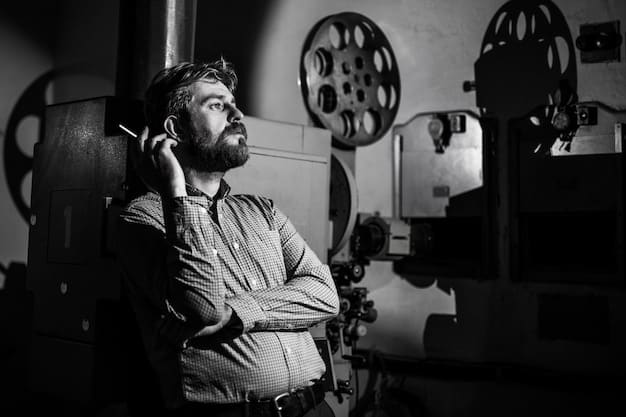The Director’s Commentary: Creative Choices Behind Controversial Endings

The Director’s Commentary offers unique insights into the creative decisions that shape a film’s controversial ending, revealing the director’s vision, challenges overcome, and the rationale behind choices that provoke debate and discussion.
Uncover the hidden layers of cinematic storytelling with the director’s commentary: insights into the creative choices behind a controversial ending. This exploration delves into the minds of filmmakers, examining the decisions that led to endings that spark debate and leave audiences pondering.
Decoding the Director’s Vision
The director’s vision is paramount in shaping the narrative and emotional impact of a film. Understanding this vision is crucial to grasping the nuances of a controversial ending.
Delving into the director’s intentions, motivations, and personal experiences provides a richer understanding of the film’s message and its controversial conclusion.
The Role of Intent
The director’s intent serves as the compass guiding the film s narrative journey, particularly in the crafting of a controversial ending. This intent is not merely a whim but a deliberate choice that reflects the director’s vision.
Personal Influence on Storytelling
A director’s personal experiences often subtly shape the narrative, adding layers of authenticity and emotion. These influences can be seen in the characters’ struggles.
- Gaining insight on themes explored.
- Discovering the emotional resonance within the narrative.
- Understanding the director’s own life experiences.

The director’s vision is the cornerstone of any film, providing a guiding light through complex narratives and challenging themes.
The Art of Provoking Thought
A controversial ending often serves to provoke thought and discussion among viewers. Filmmakers might use this technique to challenge societal norms and push the boundaries of storytelling.
Examining how these choices stimulate dialogue and encourage viewers to question their own beliefs and values reveals the power of film as a medium for social commentary.
Challenging the Status Quo
Many directors aim to challenge conventional thinking by presenting narratives that deviate from traditional resolutions. Such endings question established norms and values.
Leaving a Lasting Impression
Movies with unexpected conclusions tend to be memorable and thought-provoking. These directors create discussion and invite ongoing analysis long after the credits roll
- Considering the power of cinema as a tool for introspection and social commentary.
- Unpacking the significance of films that resonate deeply with audiences long after the credits fade.
- Understanding how the director’s commentary provides context for audiences to appreciate the film’s lasting impact.
Provoking thought through controversial endings is a strategic choice that encourages deeper engagement with the film’s themes and messages.
Navigate Narrative Risks
Stepping outside conventional narrative structures is a calculated risk. Examining these risks reveals the level of artistic freedom that the director takes to leave a mark on the audience.
The director’s willingness to defy expectations in narrative presentation can dramatically alter the film’s reception, highlighting the delicate balance between artistic expression and audience satisfaction.
Defying Audience Expectations
The decision to defy audience expectations often lies at the heart of a controversial ending. This bold move can surprise and challenge viewers.
Artistic Freedom vs. Commercial Appeal
The director’s desire to express their unique vision may clash with the commercial interests of the film industry. Balancing artistic integrity with marketability is a constant challenge.
Defying expectations and challenging convention often means navigating a thin line between artistic expression and the risk.

The Impact of Studio Interference
Studio interference, a common phenomenon in filmmaking, can significantly impact a director’s creative vision. Often, studios would favor a commercially viable conclusion.
Analyzing how studio influence can lead to altered endings and the implications for the film’s artistic integrity is essential to understand the complex dynamics within the film industry.
Creative Compromises
Studio demands might lead to creative compromises that alter the original intent of the film. These can result in controversial endings that differ significantly from the director’s vision.
Maintaining Artistic Integrity
Directors often face the challenge of preserving their artistic integrity while navigating studio pressures. They must work to protect their original vision.
- Understanding the delicate balance between artistic expression and commercial viability.
- Recognizing the director’s struggle to protect their original vision amidst studio interference.
- Insights into how the director’s commentary can illuminate the compromises made during the filmmaking process.
The director’s commentary acts as a platform of artistic intent versus the demands of commercial viability.
Technical Aspects of Crafting an Ending
The technical aspects of filmmaking, such as editing, music, and visual effects, play a significant role in shaping the ending of a movie. These contribute to creating an atmosphere.
Examining how these elements are carefully orchestrated to amplify the intended emotional impact of a controversial conclusion.
Editing and Pacing
The way a scene is edited, and the pacing of the narrative leading up to the ending, can greatly influence audience perception. Tension and suspense play integral roles.
Sound and Visual Effects
Music, sound design, and visual effects enhance the emotional impact of the ending. Sounds can create anticipation for the film’s closure.
- Evaluating the use of editing techniques to manipulate narrative threads and create suspense.
- Insights on visual storytelling to reinforce thematic and emotional cues.
- A deeper understanding that contribute to ending’s power.
Technical expertise is paramount in creating controversial ending that resonate with thought instead of confusion.
Audience Reception and Critical Analysis
Audience reaction and critical analysis offer valuable perspectives on the effectiveness of a controversial ending. The critical thinking reflects and creates discussion among each other.
By examining diverse opinions and interpretations, it is possible to gain a deeper understanding of how the film resonates with different viewers and cultural contexts.
Diverse Interpretations
Controversial endings often spark a wide range of interpretations. Every mind may think of an ending based on emotions or experiences in that moment.
Cultural Context and Relevance
The cultural context in which a film is released influences how the ending is received. Social norms may dictate opinionated views on situations.
Understanding audience receptions and critical response helps evaluate lasting presence in cinematic history.
| Key Point | Brief Description |
|---|---|
| 🎬 Director’s Intent | Exploring the director’s core vision and motivations. |
| 🤔 Provoking Thought | Challenging norms and stimulating audience discussion. |
| 🛡️ Studio Influence | Navigating studio demands while maintaining artistic integrity. |
| 🎤 Technical Aspects | Examining editing, music, and effects in shaping the ending. |
Frequently Asked Questions
Directors often use controversial endings to provoke thought, challenge norms, and leave a lasting impact on viewers. It’s a way to make the film memorable.
Studio interference can lead to altered endings that prioritize commercial appeal over the director’s artistic vision. This compromise is often a cause of contention.
Editing, music, sound design, and visual effects are critical technical elements that enhance the emotional impact and overall effectiveness of a film’s ending.
Audience interpretations and reactions can influence how a film is perceived over time, affecting its legacy and cultural impact. These are important to note.
A director’s personal experiences and viewpoints often shape the narrative, adding authenticity and emotional depth to the story. Many personal touches create unique films.
Conclusion
The director’s commentary is a window into the creative processes behind controversial film endings, highlighting the delicate balance between artistic vision, technical execution, and audience reception. Understanding these elements provides a more profound appreciation for the cinematic art.





